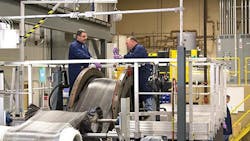3-D Plant Manufacturing Aircraft Engine Parts Opens in New Hampshire
Safran, an international high-tech company in the aerospace sector, and Albany International Corp., an advanced textiles and materials processing company, today inaugurated today a new plant in Rochester, N.H., that will produce 3-D woven RTM composite parts for aircraft engines.
“Today’s event is an important milestone in a collaboration between Safran and Albany that began in 2000 as joint research and development and that has blossomed into the unique partnership epitomized by this plant,” said Joseph Morone, CEO of Albany International Corp.
The plant, which opened during 2013, was built to produce 3-D woven composite parts using RTM technology for aircraft engine parts. The first application will be fan cases and fan blades for CFM International’s LEAP engine, dedicated to the next-generation single-aisle aircraft.
Currently 130 people are employed at the joint operation, with a total of 400-500 envisioned when full-rate production is attained.
The foundation of the LEAP engine is deeply rooted in advanced aerodynamics, environmental, and materials technologies. Particularly strong and lightweight, the 3D RTM composite parts produced by Safran and Albany will contribute strongly to provide 15% better fuel consumption compared to today’s best CFM engine, according to the companies.
Selected to power new and improved narrow-body commercial aircraft including the Boeing 737 MAX and the Airbus A320neo, the LEAP engine has achieved broad-based market acceptance with more than 6,000 engines ordered to date.
“I am very pleased to inaugurate this plant today along with our Albany International partner,” said Jean-Paul Herteman, CEO of Safran. “Our presence in Rochester reflects our commitment to this state and to the U.S. For more than 40 years, through CFM International, our exceptional long-term partnership with GE, and both organic growth and acquisitions, Safran has become a formidable presence in the U.S. Our aim is to continue to expand our position and to contribute to the development of the aerospace and security markets as an American company, to ensure optimum service for our civil and military customers here,” he added.
Safran and Albany have made significant investments in the Rochester plant, which features a state-of-the-art industrial design, and the two companies are also building a similar plant in Commercy, France, that will produce the same advanced composites parts for the LEAP engine. The Commercy plant will start operations mid-2014.
